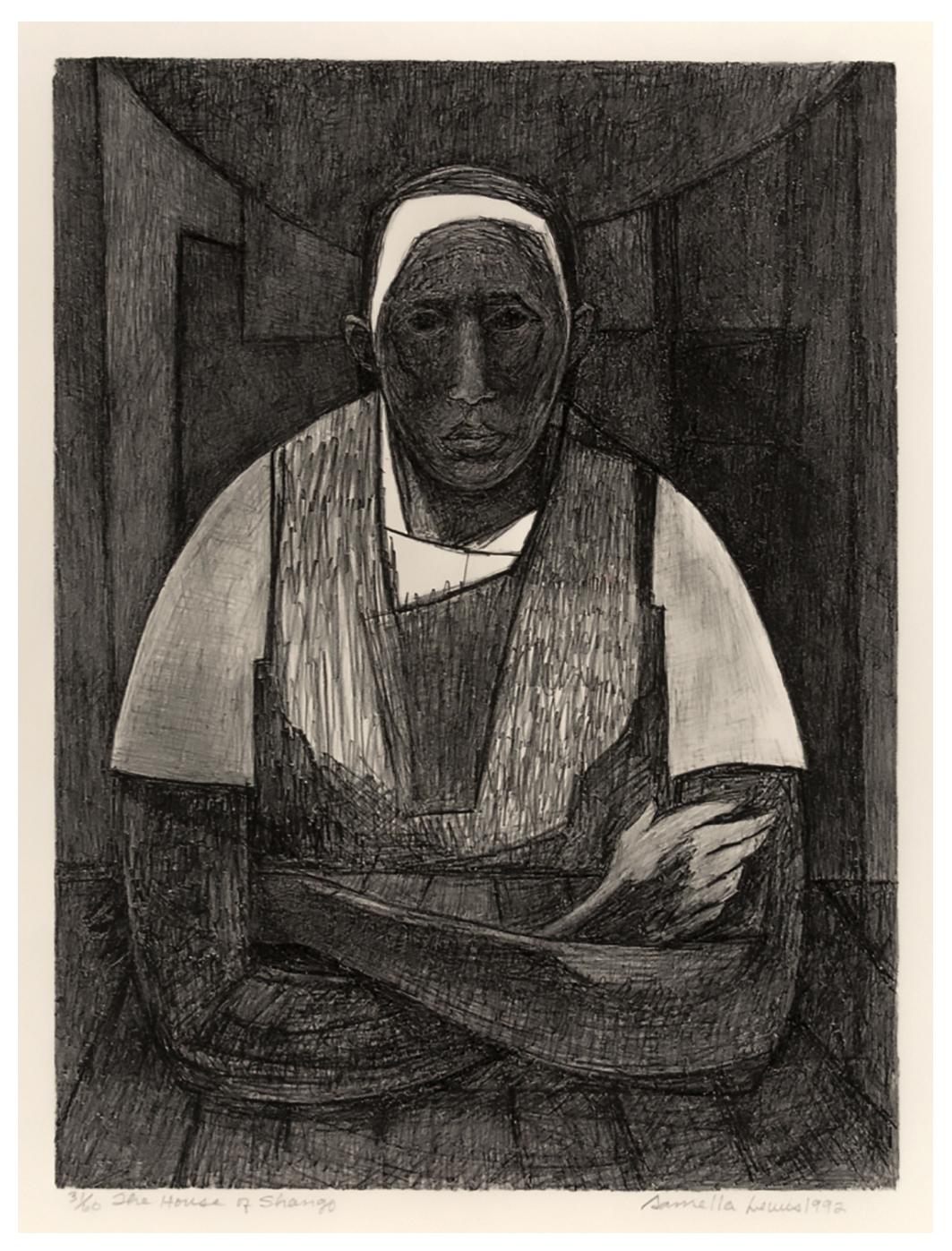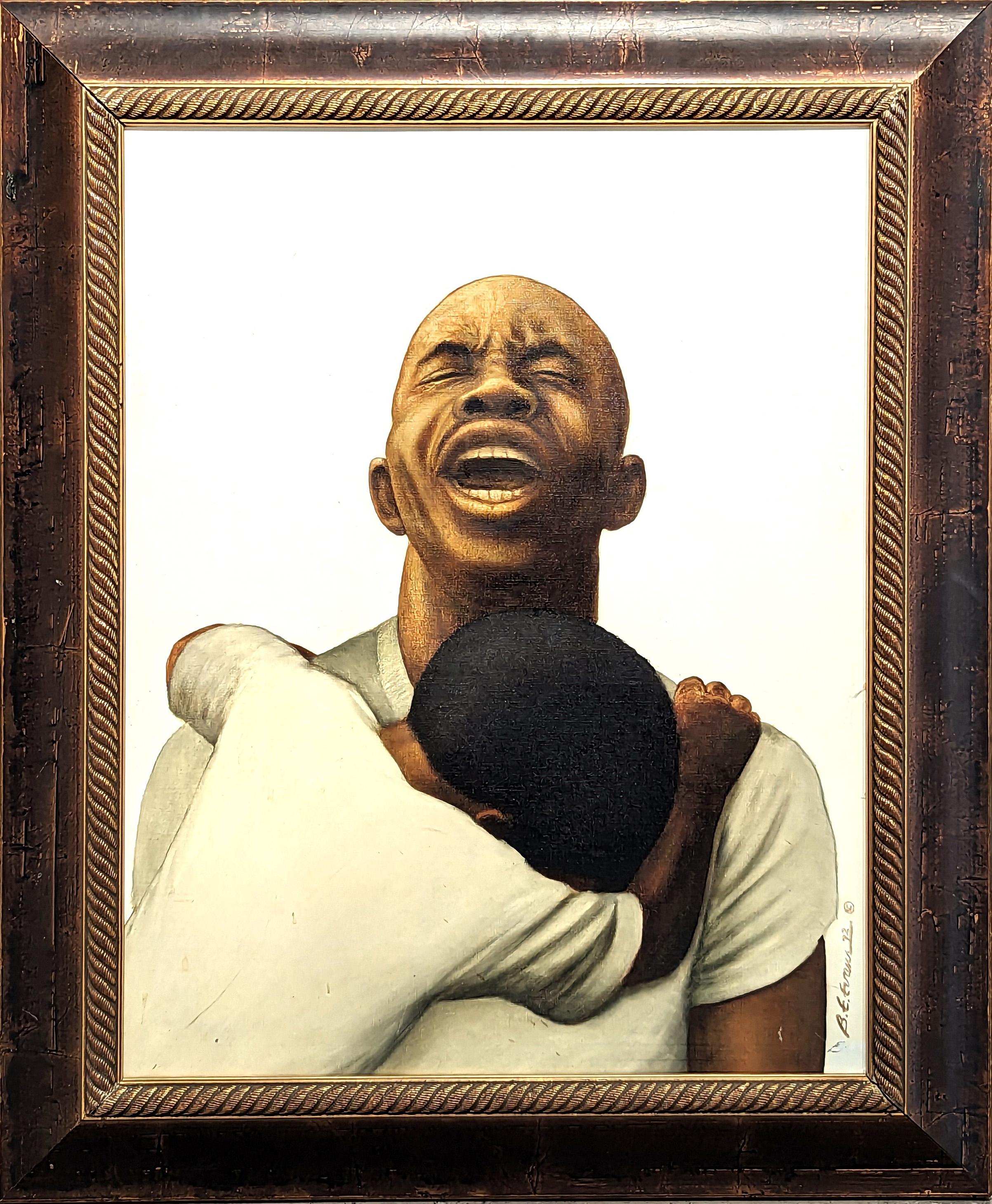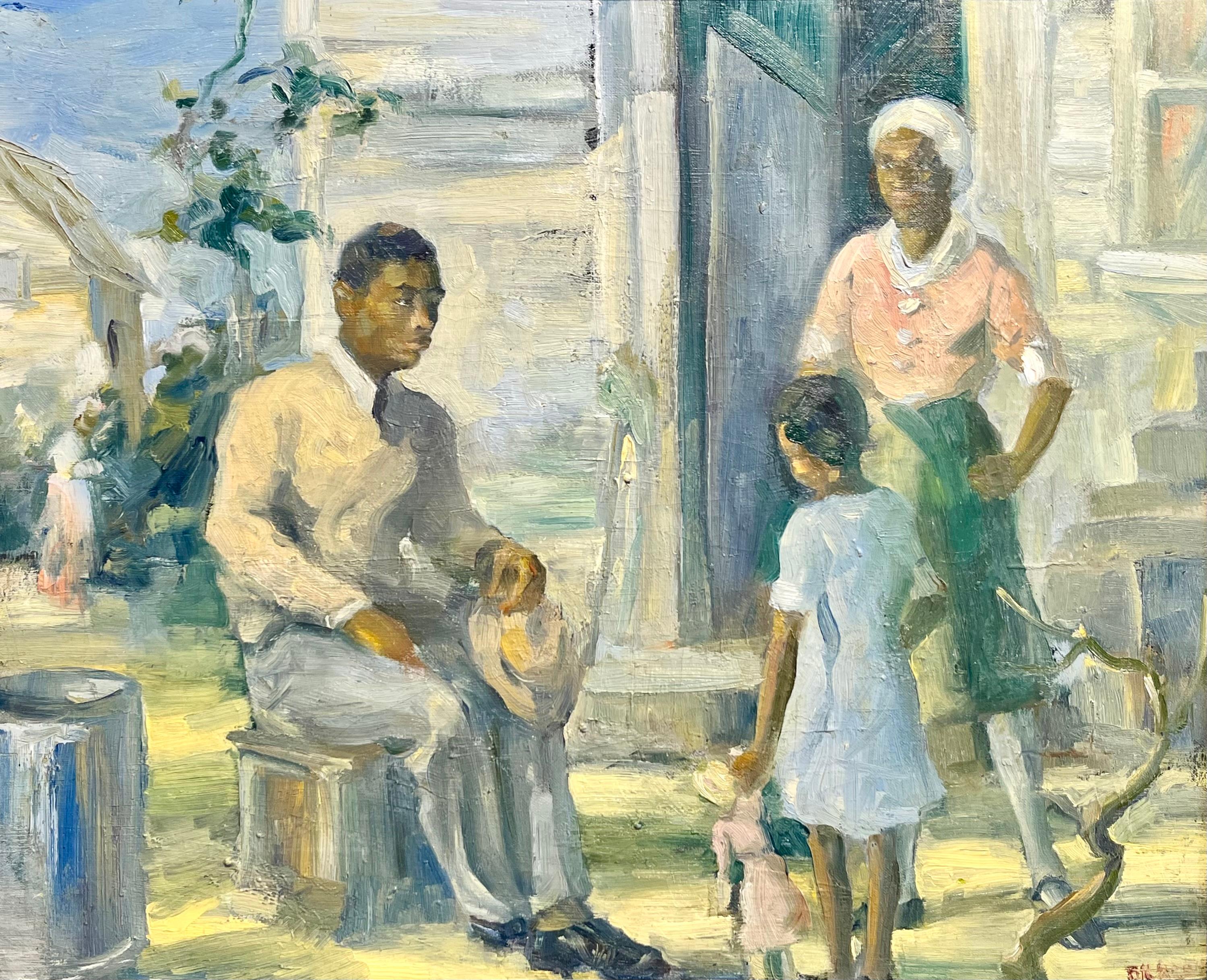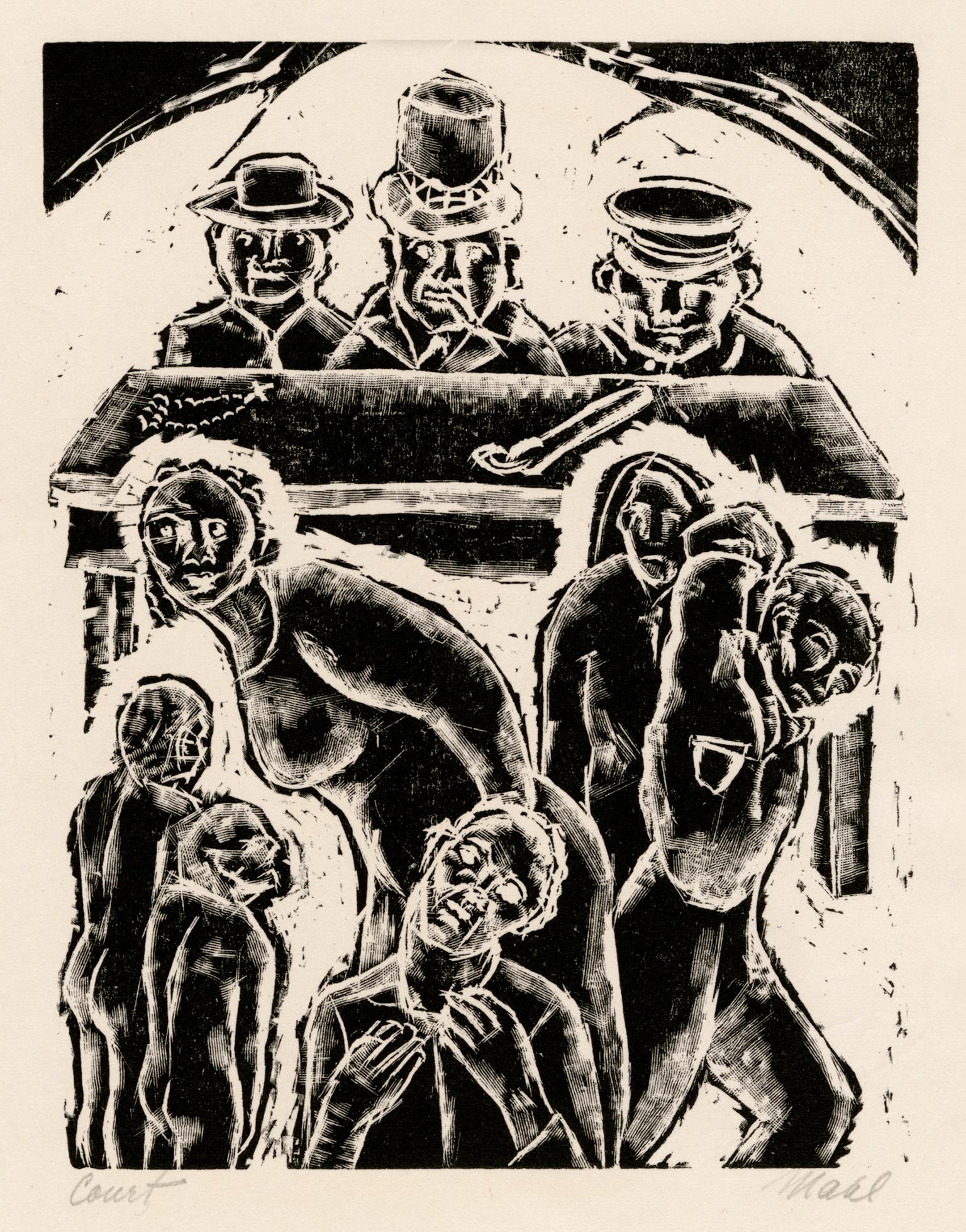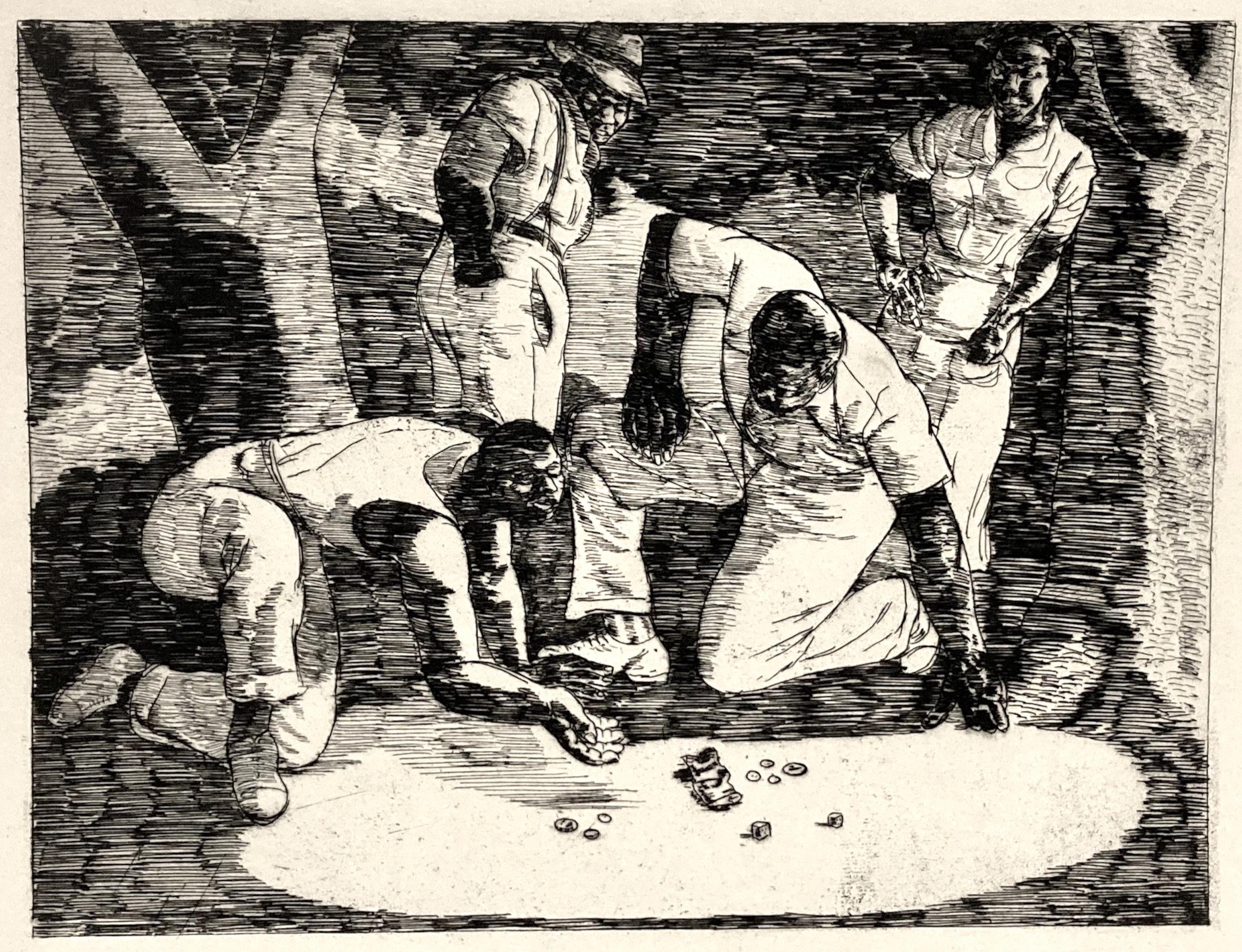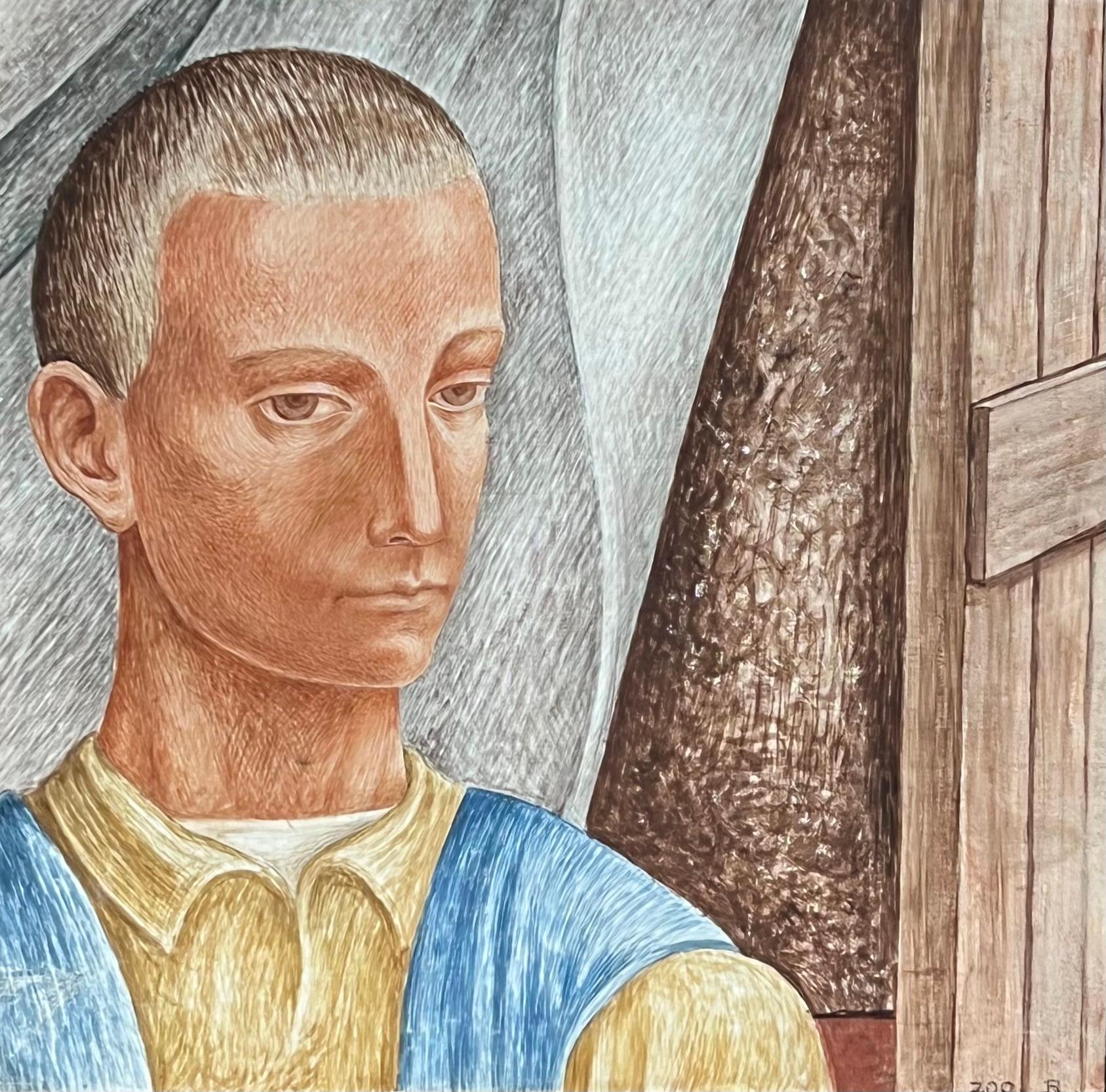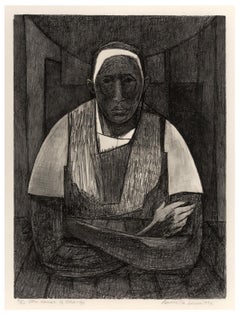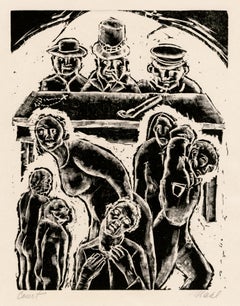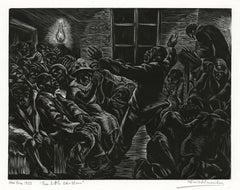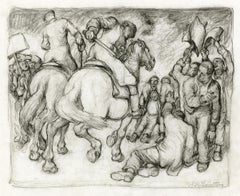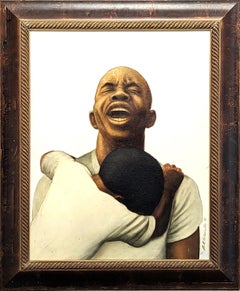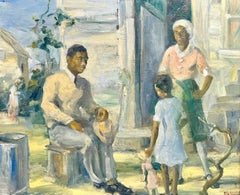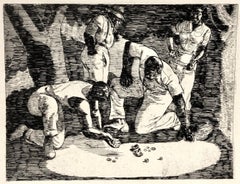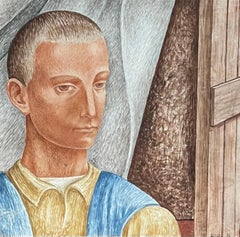Items Similar to 'Negro' — California WPA Social Realism – Slavery
Want more images or videos?
Request additional images or videos from the seller
1 of 3
Nicholas Panesis'Negro' — California WPA Social Realism – Slavery1934
1934
$2,400
£1,860.89
€2,110.52
CA$3,440.30
A$3,741.40
CHF 1,971.05
MX$45,440.02
NOK 24,780.12
SEK 23,229.37
DKK 15,845.17
About the Item
Nicholas Panesis, 'Negro', 1934, color lithograph, edition 18. Signed, dated, titled, and numbered 8/28 in pencil. Initialed in the stone, lower right. A fine impression, with fresh colors, on buff wove paper, with margins (1 1/8 to 2 3/8 inches). Minor glue staining at the extreme sheet edges verso, where previously taped (not visible recto), otherwise in excellent condition. Matted to museum standards, unframed.
Image size 10 5/8 x 8 1/2 inches; (270 x 216 mm); sheet size 14 13/16 x 10 15/16 inches (376 x 278 mm).
Created for the California Works Progress Administration, Federal Art Project (WPA). Scarce.
Impressions of this work are held in the public collections of La Salle University Art Museum (Philadelphia), U.S. General Services Administration, and Weisman Art Museum (University of Minnesota).
ABOUT THE ARTIST
Born in Massachusetts, Nicholas Panesis (1913-1967) studied art at Syracuse University, NY, and went on to teach ceramics at Alfred University, NY.
Panesis moved to San Francisco in the early 1930s shortly before settling in Los Angeles, where he worked for different animation studios as an illustrator and designer. He illustrated the cover of the book, "Fair Stood the Wind for France" in 1944, Herbert Ernest Bates' celebrated novel of the Second World War.
During the Great Depression, Panesis worked for the California Works Progress Administration. He created sensitively rendered realistic images of socially conscious subjects, including this empathetic work, ‘Negro’, and a celebrated memorial portrait of George Washington Carver.
The artist's works are held in the following public collections, California Digital Library (Federal Art Project Collection), Gibbs Museum of Art, Granger Historical Picture Archive, National Gallery of Art, and New York Public Library.
- Creator:Nicholas Panesis (1913 - 1967)
- Creation Year:1934
- Dimensions:Height: 10.63 in (27.01 cm)Width: 8.5 in (21.59 cm)
- Medium:
- Movement & Style:
- Period:
- Condition:
- Gallery Location:Myrtle Beach, SC
- Reference Number:Seller: 1034911stDibs: LU532311816612
About the Seller
5.0
Recognized Seller
These prestigious sellers are industry leaders and represent the highest echelon for item quality and design.
Platinum Seller
Premium sellers with a 4.7+ rating and 24-hour response times
Established in 1995
1stDibs seller since 2016
325 sales on 1stDibs
Typical response time: 1 hour
Associations
International Fine Print Dealers Association
- ShippingRetrieving quote...Shipping from: Myrtle Beach, SC
- Return Policy
Authenticity Guarantee
In the unlikely event there’s an issue with an item’s authenticity, contact us within 1 year for a full refund. DetailsMoney-Back Guarantee
If your item is not as described, is damaged in transit, or does not arrive, contact us within 7 days for a full refund. Details24-Hour Cancellation
You have a 24-hour grace period in which to reconsider your purchase, with no questions asked.Vetted Professional Sellers
Our world-class sellers must adhere to strict standards for service and quality, maintaining the integrity of our listings.Price-Match Guarantee
If you find that a seller listed the same item for a lower price elsewhere, we’ll match it.Trusted Global Delivery
Our best-in-class carrier network provides specialized shipping options worldwide, including custom delivery.More From This Seller
View AllThe House of Shango — African American artist
By Samella Lewis
Located in Myrtle Beach, SC
Samella Sanders Lewis, 'The House of Shango', lithograph, 1992, edition 60. Signed, dated, titled, and numbered '31/60' in pencil. A superb, richly-inked impression, on Arches cream wove paper; the full sheet with margins (1 1/4 to 3 1/2 inches), in excellent condition. Image size 24 x 18 inches (610 x 457 mm); sheet size 30 inches x 22 1/4 inches (762 x 565 mm). Archivally matted to museum standards, unframed.
ABOUT THIS WORK
“The title of this piece is an unmistakable harkening to African roots. Shango is a religious practice with origins in Yoruba (Nigerian) belief, deifying a god of thunder by the same name. Shango has been adopted in the Caribbean, most notably in Trinidad and Tobago, a fact that underscores the importance of transnationalism to Samella Lewis’s piece. Her work often grapples with issues of race in the U.S., and The House of Shango is no exception. Through a reliance on the gradual transformation of Shango—one that took place across continents and time—Lewis’s piece forms a powerful link between black Americans and their African and Caribbean counterparts. The figure depicted in the piece appears to emerge, quite literally, from the house of Shango. Given the roots and transformative process of the religion, The House of Shango can draw attention to the historical intersections to which black American culture is indebted.” —Laura Woods, Scripps College, Ruth Chander Williamson Gallery, Collection Highlights, 2018
ABOUT THE ARTIST
Samella Lewis’ lifelong career as an artist, art historian, critic, curator, collector, and advocate of African American art has helped empower generations of artists in the United States and worldwide, earning her the designation “the Godmother of African American art.”
Born and raised in Jim Crow era New Orleans, Lewis began her art education at Dillard University in 1941, transferring to Hampton University in Virginia, where she earned her B. A. and master's degrees. She completed her master's and a doctorate in art history and cultural anthropology at Ohio State University in 1951, becoming the first female African American to earn a doctorate in fine art and art history.
Lewis taught art at Morgan State University while completing her doctorate. She became the first Chair of the Fine Arts Department at Florida A&M University in 1953. That same year Lewis also became the first African American to convene the National Conference of African American artists held at Florida A&M University. She was a professor at the State University of New York, California State University, Long Beach, and at Scripps College in Claremont, California. Lewis co-founded, with Bernie Casey, the Contemporary Crafts Gallery in Los Angeles in 1970. In 1973, she served on the selection committee for the exhibition BLACKS: USA: 1973 held at the New York Cultural Center.
Samella Lewis's 1969 catalog 'Black Artists on Art', featured accomplished black artists typically overlooked in mainstream art galleries. She said of the book, "I wanted to make a chronology of African American artists, and artists of African descent, to document our history. The historians weren't doing it. It was really about the movement."
From the 1960s through the 1970s, her work, which included lithographs, linocuts, and serigraphs, reflected her concerns with the values of human dignity, democracy, and freedom of expression. Between 1969 and 70, Lewis and E.J. Montgomery were consultants for a groundbreaking exhibition at the Oakland Public L designed to create greater awareness of African American history and art.
Lewis was the founder of the International Review of African American Art in 1975. In 1976, she founded the Museum of African-American Art with a group of artistic, academic, business, and community leaders in Los Angeles, California. Lewis, the museum’s senior curator, organized exhibitions and developed new ways of educating the public about African American art. She celebrated African American art as an 'art of experience’ inspired by the artists’ lives. And she espoused the concept of African American art as an 'art of tradition', urging museums to explore the African roots of African American art. In 1984, Lewis produced an extensive monograph on Elizabeth Catlett, her beloved mentor at Dillard University.
Lewis has been collecting art since 1942, focusing primarily on the WPA era and work created during the Harlem Renaissance. Pieces from her collection were acquired by the Hampton University Museum in Virginia, the world’s earliest collection of African American fine art...
Category
1990s Realist Figurative Prints
Materials
Lithograph
'Court' — WPA Social Conscience, Woman Artist
Located in Myrtle Beach, SC
Claire Mahl Moore, 'Court' also 'The Authorities', woodcut, 1936, edition 5. Signed 'Mahl' and titled in pencil. A fine, richly-inked impression, on ...
Category
1930s Expressionist Figurative Prints
Materials
Woodcut
'Run Little Chillun' also 'Revival' — African American Subject
Located in Myrtle Beach, SC
Isac Friedlander, 'Run Little Chillun' also 'Revival', wood engraving, 1933, edition 50. Signed, titled and annotated 'New York 1933' in pencil. A sup...
Category
1930s American Modern Figurative Prints
Materials
Woodcut
Strike Breakers — social realism, Great Depression
By Daniel Ralph Celentano
Located in Myrtle Beach, SC
Daniel Ralph Celentano, Untitled (Strike Breakers) pencil, c. 1934. Signed, lower right. A fine, social-realist drawing, on cream wove paper, with margins (1 1/2 to 2 1/2 inches), in...
Category
1930s American Realist Figurative Drawings and Watercolors
Materials
Pencil
'A Wind Is Rising and the Rivers Flow' — Mid-Century American Modernism
By Benton Murdoch Spruance
Located in Myrtle Beach, SC
Benton Spruance, 'A Wind is Rising and the Rivers Flow', color lithograph, 1945, edition 40, Fine and Looney 242. Signed, dated, and titled, and annotated 'Ed 40' in pencil. A fine ...
Category
1940s American Modern Figurative Prints
Materials
Lithograph
'Unemployed Marchers' — American Modernism, WPA
By Leon Bibel
Located in Myrtle Beach, SC
Leon Bibel, 'Unemployed Marchers', 2-color lithograph, c. 1938, edition 25. Signed, titled, and numbered '2/25' in pencil. A fine, richly-inked impression on off-white, wove paper, w...
Category
1930s American Modern Figurative Prints
Materials
Lithograph
You May Also Like
“God Save the Children” Early Figurative Portrait of an Anguished Black Man
By Buford Evans
Located in Houston, TX
Early figurative portrait painting by Houston-based artist Buford Evans. The work features a black man looking to the sky with an anguished expression on his face as a young child cl...
Category
1970s Naturalistic Figurative Paintings
Materials
Canvas, Oil, Panel
Portrait of African American Family
Located in Fredericksburg, VA
This impressionist painting by Virginia artist Walter Biggs captures a moment of quiet strength and familial connection. A seated man rests outside with his hat in hand, while a youn...
Category
Mid-20th Century American Impressionist Portrait Paintings
Materials
Canvas, Oil
Irving Guyer, Roll Them Bones, Depression-era African-American men at craps
By Irving Guyer
Located in New York, NY
An American Depression-Era subject of African-American men playing craps by Irving Guyer.. (Craps is a game of chance that required neither skill nor strategy. The object is to predi...
Category
1930s Ashcan School Figurative Prints
Materials
Etching
WPA Mural Study 1940 American Scene Modern Social Realism Figurative Mid Century
By Michael Loew
Located in New York, NY
WPA Mural Study 1940 American Scene Modern Social Realism Figurative Mid Century
Michael Loew (1907-1985)
Detail for Mural (Social Security Building Washington D.C.)
24 x 24 inches ...
Category
1940s American Realist Figurative Paintings
Materials
Canvas, Oil
Hombre! Que Sin Vergeunza!
By George Biddle
Located in New York, NY
George Biddle (1885-1973), Hombre! Que Sin Vergeunza!, 1928, lithograph, signed and dated in pencil lower right, titled and numbered lower left [also signed in plate lower left ”Biddle/1928/44]. References: Pennigar 78, Trotter 44. Edition 100. In excellent condition (never framed, without light or time staining), with wide margins, the full sheet, 9 3/4 x 13 3/4, the sheet 15 1/2 x 20 1/2 inches. Printed by George C. Miller. On cream wove paper with the FRANCE watermark. Archival mounting (mylar unattached mounting between acid-free board).
A fine, fresh impression, in pristine condition.
According to Pennigar the title translates roughly to “Buddy! Aren’t you ashamed of yourself!” The title refers to the composition: the well-groomed man with his foot up in the carriage passes a group of naked little boys...
Category
1920s American Realist Landscape Prints
Materials
Lithograph
Man Working Mid 20th Century American Scene Social Realism Industrial WPA Modern
By Jo Cain
Located in New York, NY
Man Working Mid 20th Century American Scene Social Realism Industrial WPA Modern
Jo Cain (1904 - 2003)
Telephone Pole Worker
38 1/4 x 18 1/2 inches
Oil on pap...
Category
1930s American Realist Figurative Drawings and Watercolors
Materials
Paper, Gouache
More Ways To Browse
Portrait George Washington
Portrait Of George Washington
Wpa Art California
Chagall Unsigned
Chapeau Pierre
Dali Changes In Great Masterpieces
Dali Horse
Dance Of Death
Dean Mitchell
Edgar Degas Lithograph
Framed Wpa Prints
Hablot Knight Browne
Henry Moore On Sale
Henry Moore Reclining Figure
Jiang Tiefeng
Leroy Neiman Serigraphs
Marc Chagall Flowers
Max Klinger On Sale
